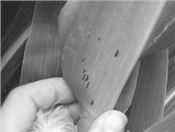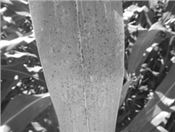|
Considerations For Early Vegetative Growth Stage Fungicide Applications On Corn
DR. KIERSTEN WISE
PRINCETON, KY.
There is renewed interest in early vegetative stage (V-stage) fungicide applications in corn this year in Kentucky, especially those occurring at the four to six leaf collar (V4-V6) growth stages. Some of this interest is driven by the wet spring and perceived risk for foliar disease development. With rainfall in western Kentucky expected this week from the remnants of tropical storm Cristobal, there are many questions regarding the need for early V-stage fungicide applications this year.
Factors to Consider
Below we discuss a few of the factors to take into consideration when deciding on whether or not to apply early V-stage fungicide applications.
University research shows the optimum timing for foliar fungicide application is VT/R1.
Over a decade of multi-state University research indicates that tasseling or early silking (VT/R1) is the optimal timing for foliar disease control and yield response from foliar fungicide applications, compared to applications that occur at early vegetative growth stages. While early V-stage applications can result in modest yield increases in some situations, these applications are less likely to provide an economic return. Recent detailed multi-state research found that early V-stage applications resulted in a yield increase of approximately 1 to 3 bushels per acre, depending on fungicide class, compared to a 3 to 7 bushels per acre yield increase from applications that occur at VT/R1. (https://doi.org/10.1371/journal.pone.0217510). It is important to remember that a V4-V6 application of fungicide to corn will not protect the ear leaf or above from disease that develops around tasseling, and a second fungicide application may be needed at VT/R1 in fields receiving early fungicide applications.
Fungicide class may affect yield response
In the previously mentioned research, fungicide class influenced yield response, with applications of products containing both strobilurin (QoI; FRAC group 11) and triazole (DMI; FRAC group 3) fungicide classes being more likely to result in a positive return on fungicide investment compared to applications of products containing only a strobilurin or triazole fungicide active ingredient. This result was true for applications that occurred in early V-stages, as well as VT/R1 applications.
Fungicide classes and efficacy of specific fungicide products for foliar diseases are described in the updated fungicide efficacy table for management of corn diseases, which is developed by the national Corn Disease Working Group, and posted on the Crop Protection Network website.
Few foliar diseases require management in the early vegetative growth stages
Farmers may be concerned about foliar diseases that can appear early in the season, such as anthracnose leaf blight (caused by the fungus Colletotrichum graminicola), which can be present in young corn. Typically, symptoms of this disease are confined to lower leaves throughout the growing season and do not typically require management. Common rust of corn, caused by the fungus Puccinia sorghi, is present at low levels in many Kentucky corn fields every year in early growth stages. The fungus that causes common rust produces brown to brick red pustules that are present on upper and lower surfaces of the leaves (Figure 1). Young leaves are more susceptible to rust infection than mature leaves. In most years, common rust does not require management in hybrid field corn in Kentucky, and the greatest concern is that common rust is accidentally confused for the more damaging southern rust disease.
Southern rust of corn, caused by Puccinia polysora, is of annual concern, and this year the movement of tropical storm Cristobal through western Kentucky has some farmers worried that the disease could cause damage earlier than normal. Although southern rust has been confirmed in Louisiana, as of June 8, it has only been confirmed in one parish at very low incidence and severity. Even if inoculum (spores) from Louisiana is deposited in Kentucky cornfields, conditions over the next week across western Kentucky are forecasted to be dry with cooler temperatures and lower humidity, which does not favor rapid and widespread southern rust development. We will be scouting and monitoring fields over the next few weeks to watch for southern rust, and issuing alerts for fungicide use if they are necessary.
Southern rust is first observed as raised, dusty orange pustules on the upper surface of the leaf (Figure 2). Pustules will typically be present only on the upper surface of the leaf. The disease is easily confused with common rust, which usually produces pustules on both sides of the leaf. If southern rust is suspected, the fastest way to get a diagnosis is to submit samples to your county agent to be diagnosed at the Kentucky Plant Disease Diagnostic Laboratory. Throughout 2020, confirmations of southern rust will be posted on the cornipmpipe website. On the map, red counties/parishes indicate that southern rust has been confirmed by university/Extension personnel.
The potential impact of southern rust in Kentucky in 2020 will depend on the crop growth stage of a field once southern rust is confirmed in an area. Previous research from southern states indicates that fungicide applications around tasseling and through milk stage (R3) are most effective at protecting yield. More information on timing of fungicide applications for southern rust can be found in Table 2 of the Crop Protection Network publication “Southern Rust”. ∆
DR. KIERSTEN WISE: Plant Pathology Extension Specialist, University of Kentucky

Figure 1. Common rust on corn
Photos: Kiersten Wise, UK

Figure 2. Southern rust on corn
|
|